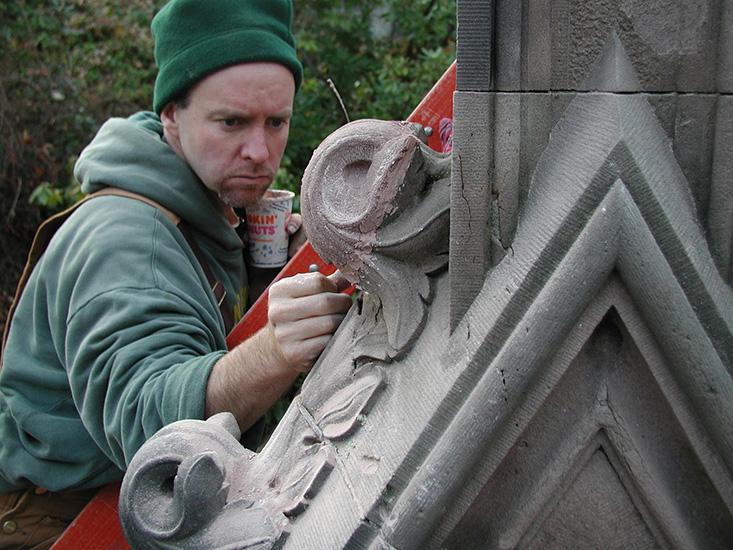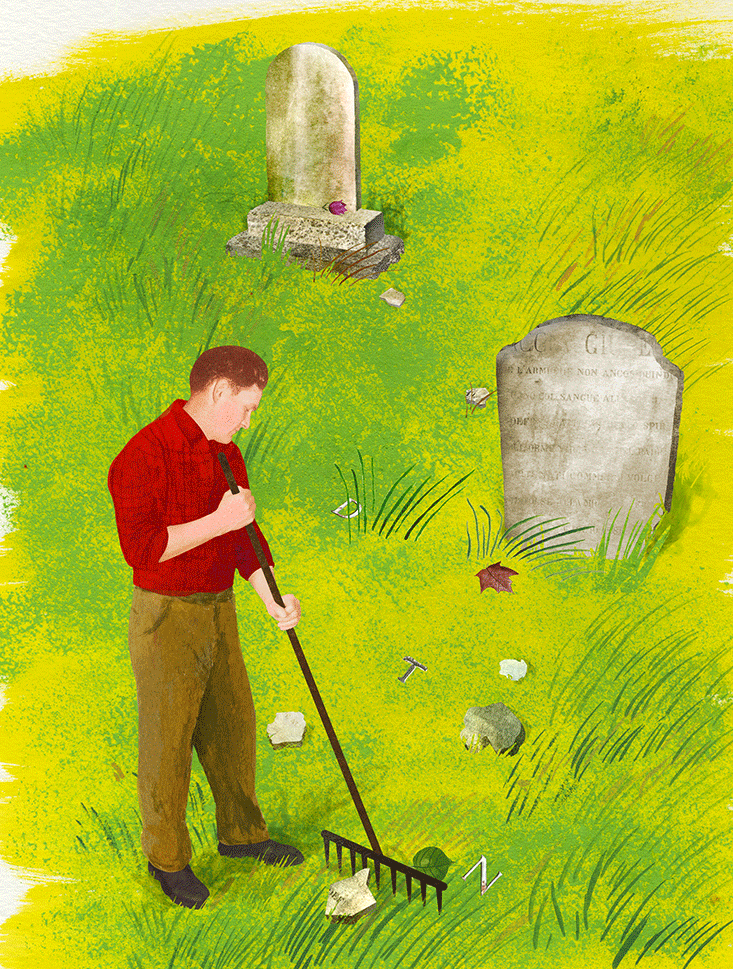On a hillside in the southeast corner of Mount Auburn Cemetery in Cambridge Massachusetts, a human’s entire life stands summed up in six lines:
ED…
A GRA…ATE….
CLASS OF….
BORN 19….
DIED 3….
AGED…
The lines adorn the remains of a house-shaped slab of sandstone. Most of its inscribed face has sheared off, making the text illegible. This is a common problem with sedimentary rocks like sandstone. Because they form in layers, they tend to come apart in layers—an unfortunate fact for Edward. Or maybe it was Edna, or perhaps just Ed.
Mount Auburn Cemetery is a 175-acre plot of graves, trees, ponds, and winding roads that is known as America’s “first garden cemetery.” I’ve spent the past two days touring the cemetery with its Chief of Conservation, David Gallagher. Slender with a high voice, Gallagher lives alone above his workshop on the cemetery grounds in an apartment containing a marble statue he sculpted on a trip to the Swiss Alps. He enjoys reading biographies in its company, and seems happy spending his days patching thin cracks in the cemetery’s old stones using custom grouts applied with dentist’s tools. When the water evaporates slowly, there’s a better chance the sealant will hold, according to Gallagher. “This isn’t rocket science, but a lot of people do it wrong,” he tells me from behind a marble obelisk.
We’ve spent most of our time together driving around the cemetery’s shaded avenues in a red and black two-seated maintenance vehicle loaded with grouts, glues, shovels, shims, and whatever other weaponry the war on entropy requires. Occasionally we stop someplace and Gallagher mournfully explains the intricacies of the damage to a monument and how he can repair or preserve what’s left. I learn about algae and acid rain, granite and slate. But mostly what I learn is that decay is both Gallagher’s enemy, and his ally.
Given the option, Gallagher wouldn’t freeze time even if he could. That might seem strange for a man whose life is devoted to scrubbing away rust stains and gluing broken marble crosses back together. But just like Sampras needed Agassi to play his best tennis, Gallagher needs decay to do his best work. “We have no preconceived notion that we’re saving these things,” he tells me. “We’re just giving them a little more time.”

The ultimate solution to tombstone decay is to make tombstones out of plastic. But good luck finding a vendor that sells synthetic markers—there’s absolutely no market for them outside of Halloween decorations. That’s not to say it hasn’t been tried though. “In the 1970s, maybe the ’80s, there was one upright headstone that was made out of plastic. It’s still out there,” says Sara Amy Leach, Senior Historian at the United States National Cemetery Administration. It has “Test” stamped on it, and is probably in Minnesota now. Mary Striegel, head of the Materials Conservation Program at the National Center for Preservation Technology and Training, says the U.S. Department of Veteran Affairs once tried a resin tombstone. “That was a huge flop,” she says. “Families didn’t feel it honored their fallen soldiers.” People preferred stone markers “for the sense of permanency, even if it’s misplaced.”
The impermanency of stone is visible everywhere at Mount Auburn. One headstone Gallagher and I stop at has been sandwiched between two wooden braces a few feet away from its rectangular base. Both pieces were struck by a snowplow during the winter, and a few chips in the base form a scar that shines bright white against the old greenish-grey rock. Gallagher’s assistant, Steve Brown, is trying to glue the monument back together. “The whole stone used to be white like that. That’s an algae growing on it,” Gallagher says, pointing to the damage.
Algae can be just as damaging as a plow. Along with fungi and bacteria, it can excrete acidic waste that eats away at the rock. Gallagher and Brown use a solution called D/2 Biological Cleaner to deal with biogrowth. It is a mixture of quaternary ammonium compounds (or “quats”) made of a central nitrogen atom attached to a chlorine atom and three other molecules.
Just like Sampras needed Agassi to play his best tennis, Gallagher needs decay to do his best work.
There’s also the problem of pollution. Pollutants like sulfur dioxide elevate the concentration of hydrogen ions in atmospheric water, resulting in acid rain. Marble is particularly susceptible to acid rain thanks to its chemical composition: It is metamorphic rock composed of limestone recrystallized under intense heat and pressure below the Earth’s surface. Limestone is made of calcium carbonate (CaCO3)—just like eggshells. If you’ve ever done the elementary school experiment where you soak an egg in vinegar, you’ve seen how readily calcium carbonate dissolves in a weak acid.
Striegel estimates that only around 25 percent of pollution-related damage comes from liquid precipitation. The other 75 percent comes from dry pollutants in the air that settle onto the stone and then dissolve in rain later. “The stone is never truly dry unless you’re in some place like the desert,” she says. When the pollutants dissolve, so does the stone.
In spite of its instability, marble remains one of today’s most popular gravestone materials. A new marble stone is striking—bright white, lustrous, and with a complex swirling grain revealed by polishing. It’s also easy to carve. The Statue of David, Madonna of Bruges, Venus De Milo, and nearly all of the world’s most famous stone sculptures have been rendered in marble. Then there is the virtue of its impermanence. Both Gallagher and Striegel doubt that buyers are choosing a stone that weathers faster on purpose. In fact, longevity is a prime concern of buyers, and they’re both frequently asked for advice on choosing long-lasting stones. People don’t want to be forgotten. But marble’s softness allows it to reflect the time that has passed. It slowly loses its smooth luster, becoming porous and sandpapery, and its texture becomes foamy like cottage cheese. “That weathering represents history,” says Gallagher.
Slate, sandstone, and granite, which are also common at Mount Auburn, present a similar tradeoff. Gallagher and I travel to one massive slab of black slate on the grounds that stood imposingly over newly repacked earth. Its lettering was razor sharp, ornate, and as smooth as glass. It was hard to imagine anything short of a bulldozer damaging it. But slate is a foliated rock. Like sandstone, it’s formed in layers, and it has a tendency to delaminate. In a few hundred years, it might be as illegible as Ed or Edna’s tombstone is today.
They want their cemetery to brag of its age, but their own markers to remain immortal.
Granite is probably the durability champion. It’s less susceptible to acid rain, doesn’t delaminate, and granite tombstones have been known to shrug off collisions with car bumpers. “Granite is a molten rock that cools over a very long period,” Gallagher explains. “This gives it time to build up the crystals and so they’re tied into each other better.” Only since the Civil War, as carving techniques have improved, has granite become a useable material for tombstones. But granite, too, starts to look old after a few hundred years; lettering loses its crispness, luster fades, edges and details melt into rounder, simpler shapes. Rain and wind slowly erode its surface. Freeze-thaw cycles in the winter expand and contract the rock, pushing and pulling its atoms ever so slightly.
Our tombstones suggest that we are not just comfortable with paradox—we seek it out. Many of us want a permanent marker, but also one that shows its age. A pile of rubble clearly does little to aid in the remembrance of a body that walked and talked and dreamed and thought. But a marker that remains too pristine loses its authority. An inscribed date might reveal when a monument was erected, but it’s the lichens, dirt, chips, and scratches that make that date convincing. We want time to be gentle, but not to stop. Leach and Gallagher both note the growing popularity of granite, spurred by the quest for maximum permanency. But at the same time many people also want to be buried in old, historic plots like Mount Auburn—as if they want their cemetery to brag of its age, but their own markers to remain immortal.
This paradox carries through to Gallagher’s job at the cemetery. Doing his job perfectly would, in some sense, be doing it wrong—something that he is very aware of. Gallagher grew up with two brothers and two sisters in Lowell, Massachusetts, the birthplace of the American Industrial Revolution. By the time he was born, in the early 1960s, the factories were mostly abandoned and the city was reeling from the economic fallout. He’s ambivalent about the city’s slow rejuvenation. “The old crustiness is gone,” he tells me. “It’s all gentrified and busine-fied” he says. He strains to avoid making the same mistake in his own work. “My worst repairs are when I’ve tried to do too much.”
As soon as an artifact is cleaned or patched, some of the history is lost. Should we scrub the green patina from the surface of the Statue of Liberty? When does the dirt become part of the artifact? “There’s a debate among preservationists of whether you should clean grave markers at all,” says Striegel. “Some of that comes from the fact that it’s a denial of the change over time, and the cleaning can ultimately cause a deterioration of the stone as well.” This has spurred the development of new technologies like laser ablation cleaning (see “Laser Tombstone Cleaning”).
Gallagher’s best work is born out of the competition between decay and stasis.
But these do little to resolve the ethical and aesthetic questions. A proper laser cleaning can turn a drab gray tombstone sparkling white, but what about its neighbors? You can’t build an ultra-modern, stainless steel and glass house on Boston’s Beacon Hill, and you can’t have one pristine tombstone in a historic section of Mount Auburn. “The cemetery is in some ways like anything that’s made up of a collection of things,” says Striegel. “You need to think about the welfare of the whole collection.” Many conservationists embrace the inevitable weathering. “I think there’s a number of people out there who enjoy historic sites … who are drawn to that [decay]. I think they’re comfortable entering into the past, if you will,” says Leach. “They’re going to melt away eventually,” Gallagher tells me. “That’s part of the beauty to me … [it] ties into a life and a death process.”

Gallagher wants to be buried when he dies. And he would like to have a nice, dark green, slate tombstone put up somewhere in the cemetery. Definitely not granite. “Granite is just hard and impermeable. There’s no softness to it,” he says. “Do you like going to a neighborhood of brand new houses, or going to an old neighborhood that’s got that ‘grown into’ feel?” I asked him how he’d feel if his own inscription became unreadable in few hundred years. “I think by that time no one is going to remember who I am anyway. So that’s ok.”
It would be easy to mistake this for a defeatist attitude—a resignation to the universe’s propensity for crumbling. But Gallagher’s best work is born out of the competition between decay and stasis. Of course his defeat is inevitable on geological timescales, but his success is evident to anyone walking on the grounds of Mount Auburn. “We’re just trying to slow things down. It’s all going to be ruins eventually,” says Gallagher. He pauses for moment then adds, “But people love ruins.”
David Shultz is a freelance journalist covering biology and science of all sorts. He tweets at @dshultz14.
Correction: As originally published, the story mistakenly referred to Mary Striegel as head of NCPTT.






























